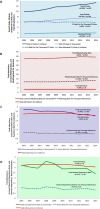Trends in the supply of California's emergency departments and inpatient services, 2005-2014: a retrospective analysis
- PMID: 28495813
- PMCID: PMC5566591
- DOI: 10.1136/bmjopen-2016-014721
Trends in the supply of California's emergency departments and inpatient services, 2005-2014: a retrospective analysis
Abstract
Objectives: Given increasing demand for emergency care, there is growing concern over the availability of emergency department (ED) and inpatient resources. Existing studies of ED bed supply are dated and often overlook hospital capacity beyond ED settings. We described recent statewide trends in the capacity of ED and inpatient hospital services from 2005 to 2014.
Design: Retrospective analysis.
Setting: Using California hospital data, we examined the absolute and per admission changes in ED beds and inpatient beds in all hospitals from 2005 to 2014.
Participants: Our sample consisted of all patients inpatient and outpatient) from 501 hospital facilities over 10-year period.
Outcome measures: We analysed linear trends in the total annual ED visits, ED beds, licensed and staffed inpatient hospital beds and bed types, ED beds per ED visit, and inpatient beds per admission (ED and non-ED).
Results: Between 2005 and 2014, ED visits increased from 9.8 million to 13.2 million (an increase of 35.0%, p<0.001). ED beds also increased (by 29.8%, p<0.001), with an average annual increase of 195.4 beds. Despite this growth, ED beds per visit decreased by 3.9%, from 6.0 ED beds per 10 000 ED visits in 2005 to 5.8 beds in 2014 (p=0.01). While overall admission numbers declined by 4.9% (p=0.06), inpatient medical/surgical beds per visit grew by 11.3%, from 11.6 medical/surgical beds per 1000 admissions in 2005 to 12.9 beds in 2014 (p<0.001). However, there were reductions in psychiatric and chemical dependency beds per admission, by -15.3% (p<0.001) and -22.4% (p=0.05), respectively.
Conclusions: These trends suggest that, in its current state, inadequate supply of ED and specific inpatient beds cannot keep pace with growing patient demand for acute care. Analysis of ED and inpatient supply should capture dynamic variations in patient demand. Our novel 'beds pervisit' metric offers improvements over traditional supply measures.
Keywords: Organization of health services; health policy; quality in health care.
© Article author(s) (or their employer(s) unless otherwise stated in the text of the article) 2017. All rights reserved. No commercial use is permitted unless otherwise expressly granted.
Conflict of interest statement
Competing interests: None declared.
Figures


Similar articles
-
Trends in the use and capacity of California's emergency departments, 1990-1999.Ann Emerg Med. 2002 Apr;39(4):389-96. doi: 10.1067/mem.2002.122433. Ann Emerg Med. 2002. PMID: 11919525
-
Understanding hospital and emergency department congestion: an examination of inpatient admission trends and bed resources.CJEM. 2010 Jan;12(1):18-26. doi: 10.1017/s1481803500011970. CJEM. 2010. PMID: 20078914
-
National trends in emergency department closures, mergers, and utilization, 2005-2015.PLoS One. 2021 May 20;16(5):e0251729. doi: 10.1371/journal.pone.0251729. eCollection 2021. PLoS One. 2021. PMID: 34015007 Free PMC article.
-
Pediatric observation status beds on an inpatient unit: an integrated care model.Pediatr Emerg Care. 2004 Jan;20(1):17-21. doi: 10.1097/01.pec.0000106238.72265.5f. Pediatr Emerg Care. 2004. PMID: 14716160 Review.
-
How do we identify acute medical admissions that are suitable for same day emergency care?Clin Med (Lond). 2022 Mar;22(2):131-139. doi: 10.7861/clinmed.2021-0614. Epub 2022 Jan 19. Clin Med (Lond). 2022. PMID: 35046012 Free PMC article. Review.
Cited by
-
Emergency Department Closures And Openings: Spillover Effects On Patient Outcomes In Bystander Hospitals.Health Aff (Millwood). 2019 Sep;38(9):1496-1504. doi: 10.1377/hlthaff.2019.00125. Health Aff (Millwood). 2019. PMID: 31479367 Free PMC article.
-
Spatial equity and factors associated with intensive care unit bed allocation in China.Arch Public Health. 2024 Sep 29;82(1):169. doi: 10.1186/s13690-024-01402-5. Arch Public Health. 2024. PMID: 39343936 Free PMC article.
References
-
- Emergency Medical treatment and Active Labor Act. 42 USC §1395dd 1986.
-
- Gonzalez Morganti K, Bauhoff S, Blanchard JC, et al. . The evolving role of emergency departments in the United States. Santa Monica, CA: RAND Corporation, 2013. http://www.rand.org/content/dam/rand/pubs/research_reports/RR200/RR280/R... (accessed 1 Oct 2015). - PMC - PubMed
-
- Melnick GA, Fonkych K. Is California’s hospital-based ED system eroding? Oakland, CA: California HealthCare Foundation Issue Brief; 2009.
-
- Weiss AJ, Wier LM, Stocks C, et al. . Overview of emergency department visits in the United States, 2011. HCUP Statistical Brief #174, Rockville, MD: Agency for Healthcare Research and Quality, 2014. https://www.hcup-us.ahrq.gov/reports/statbriefs/sb174-Emergency-Departme... (accessed 15 May 2016). - PubMed
MeSH terms
LinkOut - more resources
Full Text Sources
Other Literature Sources
Medical
